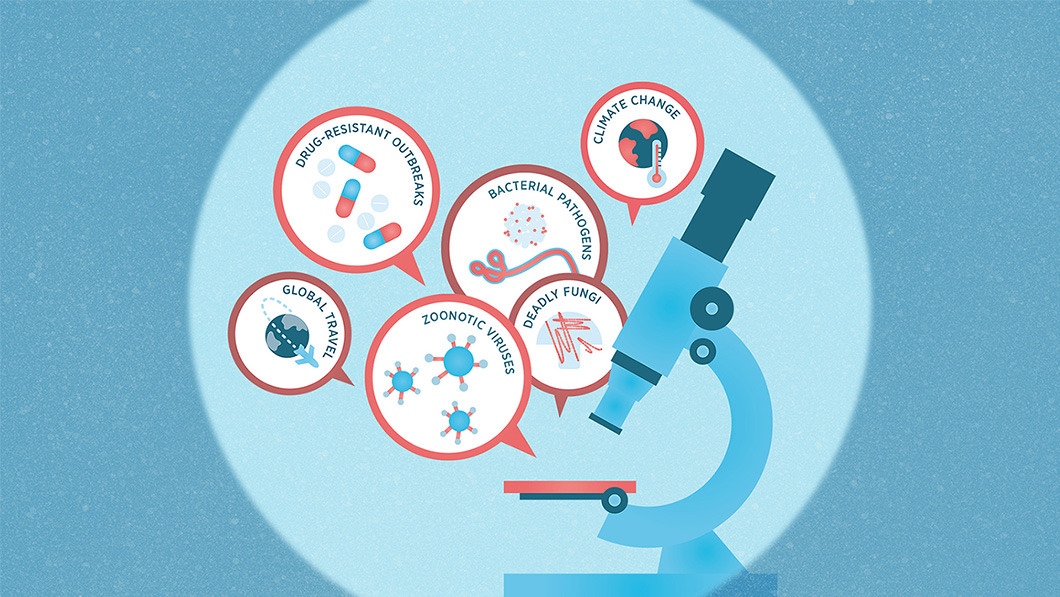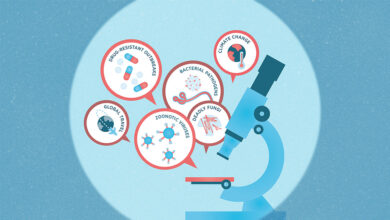
PPF Health Security: Disease X and empty labs
Sponsored by:

PPF’s report The Next One: Preparing Canada for another health emergency outlines the lessons learned from the pandemic and how Canada can safeguard against future health emergencies. To keep the discussion going — and to keep Canadians informed — this newsletter looks at what’s happening in the world of health security each week. Here’s what we’re following:
Measles in North America
More than half of the world’s countries are at high or very high risk of seeing outbreaks of measles by the end of 2024 unless they act quickly, the WHO said last week. Meanwhile, Ontario’s Chief Medical Officer of Health issued a memo to some public health units telling them to prepare for potential outbreaks. There have now been five confirmed cases of measles in Canada this year; there were 12 total confirmed cases in all of 2023.
Measles is no longer endemic in Canada, but vaccination rates against it appear to be falling, according to data from the 2021 childhood national immunization coverage study. The proportion of children who had received two doses of the measles vaccine prior to their seventh birthday fell nationally from a high of 87 percent in 2017 to 79.2 percent in 2021. That’s far below the national target of 95 percent. It’s “just a question of time” before a measles case brought to Canada sparks an outbreak, Dr. Charles Hui, a pediatric infectious disease specialist with CHEO and the University of Ottawa, told the CBC last month.
The situation in the U.S. is similar. Last week, four measles cases were reported in a Florida school district, including a boy who had not recently travelled abroad. The school, Manatee Bay Elementary, in Broward County, has an 89.31 percent vaccination rate against measles, according to CBS News. In the U.S., vaccination exemptions rose to three percent for the 2022-23 school year, the highest rate ever reported, the majority of which were not for religious reasons, according to data compiled by the Centers for Disease Control.
Also this past week, the UK Health Security Agency reported that measles is now present in all regions of England — beyond the original outbreak epicentre in the Midlands.
Fighting “Disease X”
Tedros Adhanom Ghebreyesus, the head of the WHO, told CNN that the world remains unprepared for the next pandemic, echoing comments he made earlier this month at the World Government Summit. The world’s nations still have problems such as sharing timely and transparent information, technology and coordinating response, he told the network. He reiterated his call for countries to join a new pandemic accord to solve these issues.
Working against that is an information landscape replete with conspiracy theories. In recent weeks, the misinformation cycle has focused on “Disease X”, the placeholder name the WHO has given a future potential pandemic, just as it had earlier anticipated something to arise prior to COVID-19. Conspiracy theorists falsely believe Disease X is a planned outbreak and that the pandemic accord will strip countries of their sovereignty (also false).
As the Washington Post reported this week, misinformation can be big business. Its analysis of tax records shows four American nonprofits associated with spreading medical misinformation about COVID-19 collectively gained US$118 million between 2020 and 2022. Among the nonprofits the Post examined was Robert Kennedy Jr.’s anti-vaccine group, Children’s Health Defense. It received $23.5 million in contributions, grants and other revenue in 2022, eight times what it collected in the year prior to the pandemic, according to the Post.
The majority of the funds are used to influence the media and political ecosystems, muddying the information waters or exerting pressure on politicians and health officials. To help push back, earlier this month, the Johns Hopkins Bloomberg School of Public Health released a guidance document to help doctors and others address harmful rumours and misinformation.
RELATED READING: How health misinformation is taking a toll on well-being
Respiratory illness boom
New data from the Canadian Institute for Health Information reveals a significant increase in hospital stays for children with respiratory illness. Among CIHI’s findings was that there were 2,444 hospitalizations for seasonal flu for kids under 4 in 2022-23, a huge increase from the previous year, when there were only 33.
There were also large increases in hospital stays for other respiratory illnesses, including for bronchitis, which increased to more than 19,000, up from 9,500 the prior year. Hospitalizations for pneumonia tripled, from just over 3,400 to more than 9,800. Hospitalizations due to COVID-19 were up as well, 43 percent from the previous year to just over 3,300 total. CIHI representative Nicole Loreti told a Winnipeg radio station that the data reinforces the need for public health measures like annual flu and COVID vaccines.
Burnout-fighting AI
A survey of U.S. doctors commissioned by cloud-based health-care company Athenahealth has revealed that 90 percent report feeling burned out on a “regular basis,” most of which is caused by administrative tasks. Sixty-four percent said they feel overwhelmed by clerical work. The study also found that 60 percent of respondents said they were thinking about leaving medicine. A study survey from the Canadian Medical Association earlier this year also found that administrative work is a key source of strain and unhappiness for Canadian doctors.
But the Athenahealth survey also found that most respondents are hopeful that Artificial Intelligence can help make their lives easier. A full 83 percent of those surveyed said they think technology will help also improve the accuracy of diagnoses and help to better identify patterns and anomalies in patient data, among other things. However, those doctors might have a while yet to wait before AI is implemented in their workplace. A separate survey commissioned by the Center for Connected Medicine in Pittsburgh found that only 16 percent of U.S. hospital and health system executives said their organizations have a system-wide governance policy in place for AI usage and data access. “Many organizations remain in the early stages of evaluating and implementing AI solutions,” the survey authors noted, adding that several respondents are waiting on federal regulations before developing their own policies.
Lab space crash
The pandemic sparked an unprecedented boom in life sciences investment. But where there’s a boom, a bust is sure to follow. Funding for life sciences startups is drying up, something that is now evident in millions of square feet of now-empty lab space. In the Cambridge and Boston areas (home to pharmaceutical firms like Moderna and Biogen), venture capital firms “looking to fund the next lucrative disease treatment or prescription drug” fueled a construction frenzy. Spending on life sciences in the region hit $45 billion in 2021, up from $25 billion in 2018. Five million square feet of lab space was added. But the sharp rise in interest rates beginning in 2022 put a halt to the building and to the flow of money.
Venture capital funding has since become much more conservative, placing bigger bets on a smaller number of companies that offer a higher chance of success. “The life sciences landscape changed, too. Coronavirus vaccines debuted much faster than expected, slowing what had been an insatiable thirst for new companies and new research,” explains the Post.
It may take some time — possibly years — before the VC funding market in life science bounces back and “investors get more comfortable putting their wealth in risky assets seeking enormous payoffs.”
Events:
March
- March 3-5: ACDM24. Copenhagen, Denmark.
- March 8: Networking with Inspiring Women in Science. Toronto, ON
- March 8-12: SXSW Health and MedTech Track 2024. Austin, TX.
- March 11-15: 2024 HIMSS Global Health Conference. Orlando, FL.
- March 11-15: LAMedTechWeek. Los Angeles, CA
- March 14-17: Annual World Conference of SBMT. Los Angeles, CA
- March 19-21: Rare Diseases Summit. Philadelphia, PA.
- March 25-27: Ketamine and Related Compounds International Conference 2024. Oxford, UK
- March 26-28: Precision Med TRI-CON. San Diego, CA
April
- April 15-17: Bio-IT World Conference & Expo. Boston, MA
- April 17-18: CMO Summit 360. Boston, MA.
Did someone forward you this newsletter? Subscribe to PPF: Health Security newsletter
Related Articles



